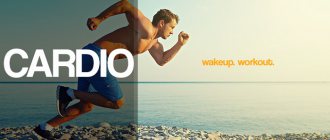Training twice a day is real! And they can be very different. They can be used for weight, strength and weight loss. And there is nothing unusual about this! But training twice a day requires appropriate organization of rest. Because training twice a day and recovering incorrectly is pointless! All this can lead to is muscle pain . And there is nothing good about it. It only slows down progress. Because progress in results is ensured by progression of loads. Which is simply impossible in the case when the muscles have not yet reached the moment of supercompensation . And it will come later, the less adequate the load is to your level of training.
Another important element of training twice a day is the recovery process. Namely, diet and sleep-wake patterns. Therefore, it is recommended that you familiarize yourself with the weight loss diet or weight loss diet . For women - with a diet for fit-necks . Read about organizing a proper sleep schedule in our article on its benefits. BUT! It is important to understand that you cannot work hard all day between workouts, drink alcohol, or otherwise interfere with recovery. More precisely, you can, of course, work in an office. You can take a walk. You can meet a girl or a guy. But all this needs to be adjusted to suit your feelings and cut back if you feel under-recovered for the next workout.
Strength training twice a day
Day #1
Morning Barbell squats - 5 sets of 5 reps Romanian deadlifts - 4 sets of 6 reps Lying leg curls - 4 sets of 8 reps Exercise bike - 40 minutes
Evening Bent-over barbell rows - 6 sets of 6 reps Seated dumbbell swings - 4 sets of 8 reps Bench press - 6 sets of 6 reps Arm extensions on a block - 4 sets of 8 reps
Day #2
Morning Classic deadlift - 6 sets of 6 reps Hyperextension - 4 sets of 8 reps Exercise bike - 40 minutes
Evening Front squats - 4 sets of 8 reps Seated leg extensions - 4 sets of 8 reps Angled barbell press - 4 sets of 6 reps Lat rows - 4 sets of 6 reps
Day #3
Morning Romanian deadlift - 4 sets of 8 reps Donkey - 4 sets of 8 reps Hyperextension - 4 sets of 10 reps Exercise bike - 40 minutes
Evening T-bar rows - 4 sets of 8 reps Biceps curls - 6 sets of 6 reps Dumbbell swings - 4 sets of 8 reps
Notes* rest in basic exercises 2-3 minutes, in auxiliary exercises 1-2 minutes; you can train every day; duration of the scheme is 1 month; The scheme can be used both for targeted development of strength indicators and as a developmental cycle of a weight program; It is recommended to take creatine . Be sure to use a diet for weight!
Is it possible to go to two group training sessions in a row (spoiler: yes, but not for everyone) - Om Activ
- Don't forget to let your body recover. A minimum of one day of rest from any training per week is the law.
Cardio training
If your goal is not only tone, but also fat burning, in addition to strength training, attend cardio training.
The variety is amazing: cycling, step aerobics, combat, various dance programs: Latin, Zumba, etc. These workouts not only effectively help burn fat, but also perfectly train the cardiovascular system and develop endurance. Main goal: burning fat.
Number of workouts per week: two. Of course, if you are preparing for a marathon or setting specific running goals, more.
Body&Mind
Regardless of your training goal, attend training sessions from the so-called “Body&Mind” series. There is yoga, Pilates, tai chi, callanetics and stretching. The purpose of these classes is to stretch and relax muscles, strengthen and stabilize the deepest layers of muscles, and train balance and breathing.
Main goal: stretching.
Number of workouts per week: at least one. Two workouts are already very good. If you want more, stretch more, but don't forget to rest from all workouts, even stretching, at least one day a week.
In addition to all of the above, some clubs also offer group training in the pool. The aquatic environment provides significant resistance to movement in all directions, thereby involving the muscles in work. Also, exercise in water improves blood circulation and strengthens the heart muscle.
Now let's talk about the duration and intensity of the workout.
Classic group programs – hour. There are also 30-minute and 45-minute classes. As a rule, the longer the workout, the lower the intensity.
- So, an intense 30-minute workout may already be enough. But you can attend two hour-long workouts (not just any) in a row without harm. All the rest of the work is already worn out.
Optimal combinations: two for 30 minutes, one for 30, another for an hour or two for an hour, but no more.
- 1 Strength/functional/interval (30-60 min) + cardio (30 min)
- 2 Strength/functional/interval (30-60 min) + “Body&Mind” (30-60 min)
- 3 Strength/functional/interval (30-60 min) + pool training (30-60 min)
- 4 Cardio workout (30-60 min) + pool workout (30 min)
- 5 Cardio training (30-60 min) + “Body&Mind” (30-60 min)
- 6 Training in the pool (30-60 min) + “Body&Mind” (30-60 min).
Bad ideas:
- 1 Two (or more) hour-long strength/functional/interval training sessions in a row. If you still have energy in the second hour, then the intensity during the first hour was too low for you. Next time, increase the working weights.
- 2 Any combination of workouts that take more than two hours. Either you work too hard (no need), or you don’t work enough. If the latter, increase the intensity.
- 3 Hour cardio training after strength/functional/interval training. Long-term cardio is best done on a separate day due to high levels of cortisol in the blood, which destroys muscles. We wrote about this in detail here. After a hard workout, a light jog, no more than half an hour, will be enough.
- 4 Stay for the second workout feeling hungry. After half an hour of physical activity, you may feel hungry. It is associated with a decrease in blood glucose levels. Increased activity of the nervous system with a lack of glucose can cause negative processes in the body. So if you feel hungry but want to go for another workout, eat a banana or a fitness bar.
- 5 On the first day in the gym, do everything. The level of physical fitness is of great importance. Start with one hour or half-hour workout a day, exercise two to three times a week. The more often you exercise, the faster your body adapts to the load, and your level of physical fitness increases.
If everything is not enough, increase the intensity. Increasing your working weights, being less distracted by your phone, or even leaving it in the locker room also helps.
Workout twice a day for mass and cutting
Morning Leg press - 4 sets of 15 reps Seated leg extensions - 3 sets of 15 reps Lying leg curls - 4 sets of 15 reps Bench press - 3 sets of 12 reps Lat rows - 3 sets of 12 reps Exercise bike - 15 minutes for mass and 40 minutes to dry
Evening Romanian deadlift - 4 sets of 12 reps Hyperextension - 3 sets of 15 reps Angled barbell press - 3 sets of 12 reps Cable arm extensions - 3 sets of 12 reps Lower block row - 3 sets of 12 reps Seated dumbbell swings - 3 set of 12 repetitions Exercise bike - 15 minutes for mass and 40 minutes for drying
Notes* rest 30‒60 seconds; you need to train daily; duration of the regimen is 1–2 months for weight, 1–3 months for weight loss; When gaining weight, you should use a weight-loss diet, and when losing weight, use a weight-loss diet. It is not necessary to take sports nutrition, but you can use the scheme outlined in the article about the anabolic window .
Training programs
The role of beta blockers in cardiologist practice in the light of recent research
Oksana Mikhailovna Drapkina , professor, doctor of medical sciences:
– Professor Alexey Olegovich Shevchenko: “The role of beta blockers in the practice of a cardiologist in the light of recent research.”
Alexey Olegovich Shevchenko , professor, doctor of medical sciences:
– The effect of beta blockers is primarily due to the fact that they prevent the toxic effect of catecholamines. Beta adrenergic receptors are found in most cells and in most tissues of the body. Therefore, in addition to reducing heart rate, improving myocardial filling, antiarrhythmic action, anti-ischemic action, reducing renin levels, there are a number of additional actions, which are sometimes called pleiotropic, and sometimes these are simply new effects that are discovered in connection with the study of the functions and mechanisms of action of beta -adrenoreceptors.
At least clinically, the first place should be given to the use of beta blockers for the purpose of cardioprotection as antiarrhythmic drugs. Of course, they have a powerful anti-ischemic effect and hypotensive effect. And the larger number of patients, of course, in whom beta-blockers actually have a clear and proven effect are patients, first of all, of secondary prevention, but also patients with arterial hypertension.
Of course, the history of beta blockers goes back almost 50 years. 48 years ago, the most successful beta blocker that appeared, before that there were other drugs, but in 1964, in the May edition of The Lancet, an article appeared, “A new adrenergic drug: Propranolol,” which was created in the laboratory of James Black, for which he received the Nobel Prize in 1988.
Over the past few decades, drugs have been used and studied, and of the most controversial issues that exist today, I would highlight two, although there are, of course, more. First: how unique are they? And second: the peculiarity of clinical application in various situations. At least the uniqueness of beta-blockers, of course, primarily concerns their interchangeability, because different molecules are used. We have a fairly large number of “good” beta-blockers, and on the other hand, the same molecules are produced by different manufacturers. In particular, all beta-blockers, due to their beta-blocking action, effectively reduce the risk of death and effectively reduce the risk of recurrent myocardial infarction. On the other hand, studies that have also been around for quite a long time have shown that the more highly selective the drug is, and if it lacks internal sympathomimetic activity, the more effective it is relative to others in reducing the risk of developing undesirable cardiovascular events. To date, we do not use drugs with intrinsic sympathomimetic activity, but in terms of selectivity, they do differ. Selectivity for beta-blockers is a very relative indicator: selectivity may decrease with increasing dose.
We have good non-selective beta blockers that we use. Of course, that same fast and short-acting Propranolol, which appeared very first, which has not left us anywhere. Sotalol, which has good antiarrhythmic activity, including the properties of a class III antiarrhythmic. Carvedilol is an excellent drug, an alpha1, beta1, beta2 antagonist, which also has a proven effect in patients with heart failure.
Medications of moderate selectivity. What does “moderate selectivity” mean? In small doses, there are practically no side effects associated with blocking beta2 receptors, but with increasing doses this effect is noticeable, and has been shown in many studies. Moderate selectivity includes hydrophilic Atenolol and lipophilic Metoprolol.
The most highly cardioselective drugs. Today, the ones we have are, of course, Nebivolol and Bisoprolol. Which of them is more cardioselective is actually a very controversial question. They both turned out to be more cardioselective relative to other beta-blockers. But when they tried to compare them with each other, it turned out that the results were contradictory. As an example, one study done in 2002 showed that Nebivolol was four times more cardioselective than Bisoprolol. Under the same conditions, a study was conducted in another laboratory - and they saw that, on the contrary, Bisoprolol turned out to be several times more cardioselective than Bisoprolol. It’s probably difficult to answer here - different studies really gave different data. But there is probably no question that they have greater cardioselectivity than others.
And the second question is small, but nevertheless takes a lot of time - this, of course, is the question of the interchangeability of products produced at different factories by different manufacturers. We live in a difficult time when we have non-medical terms associated with rebranding, franchising, globalization, when even one drug, which was originally produced by one company, is transferred to another company, then a third one appears, then so-called generics appear. And here it is necessary not only to prove that the drug has the same bioequivalence: it is excreted at the same rate, distributed in the same quantities in the blood, but also, probably, clinical evidence.
As an example: literally at the beginning of this year, the work of Professor Protasov and co-authors was published, who studied the effectiveness of Bidop - this is Bisoprolol produced and the drug Concor - this is Bisoprolol, which appeared first. In a crossover study in patients, it was found that the practically hypotensive effect of Bidop is no different from Bisoprolol, which was the first to appear, from Concor. Similarly, we conducted the same small crossover study, already trying to evaluate anti-ischemic activity. And they saw that Bidop did not differ from Concor in terms of its effect on the duration of physical activity and the number of attacks. And there are quite a large number of similar studies; they showed that Bisoprolol produced by Gedeon Richter was no different from the same Concor that appeared first.
Several months ago, we demonstrated, including here, the results of our research on the prescription of cardiovascular drugs to patients with psoriasis. And in the same way, Bisoprolol produced by both one and another company, being a highly cardioselective drug, not only did not lead to an increase in side effects of therapy, but was also accompanied by a significant improvement in the clinical status of patients.
The second question is, of course, the features of the clinical use of beta-blockers. Probably, beta-blockers for arterial hypertension have raised the most questions over the past few years. The reason is as follows. On the one hand, indeed, they have a huge number of mechanisms with which the hypotensive effect is associated, and they have a hypotensive effect. In addition to reducing the bioavailability of catecholamines, they have quite effective, including antirenin, effects. There is now debate about the role of renin itself as a central molecule in arterial hypertension, but nevertheless, beta-adrenergic receptors, especially beta-1 adrenergic receptors, are very strongly represented in the juxtaglomerular apparatus. And according to many studies, beta blockers - in particular, the results with Atenolol and Bisoprolol are presented here - are just as effective in reducing plasma renin activity as a superselective renin receptor blocker. And it has even been shown that a single dose of one tablet of Bisoprolol 10 milligrams leads to a decrease in plasma renin activity by 65%, and this effect lasts for almost a week.
On the other hand, what causes this very paradox? Because several years ago a number of meta-analyses were presented, which showed: when beta-blockers were prescribed at the stage of primary prevention, that is, in patients who had not suffered a myocardial infarction, then for some reason they developed symptoms after some time. Especially, unfortunately, in women, mortality from all causes, mortality from cardiovascular diseases, heart attacks, and strokes increased. Of course, we can say that meta-analyses have some negative sides, although they probably have much more positive sides. But what were the assumptions and theories? At first, everyone “pointed the finger” at Atenolol, although in fact some people think that maybe in vain, because Atenolol is an amazing drug that is still used in many countries around the world. Yes, it's cheap, yes, it's not that new, yes, it's not that fashionable. But maybe he was prescribed incorrectly? In those studies where he lost, where he showed perhaps insufficient activity, he was prescribed once and in fairly high doses: 50 or 100 milligrams. If we were to prescribe it twice a day, in the morning and in the evening, even though we now have a fairly large number of long-acting drugs for a single dose, Atenolol still did not overlap the day. Of course, a negative metabolic effect could also have had an impact. Beta-blocker drugs, especially non-selective and moderate cardioselective ones, have a more pronounced negative effect on both lipid metabolism and carbohydrate metabolism.
Another interesting idea, which was presented in several works, both physiological and clinical, is the so-called idea of pulse wave desynchronization, the meaning of which is that if artificially in patients who have not suffered a myocardial infarction and without pronounced remodulation of the arterial wall to slow down the rhythm with medication, this actually leads to the fact that the return wave arrives at the aortic valves not in diastole as expected, but in systole or in some other phases. In this case, there is a collision of two waves, ascending and reflected, and the result is what we saw in the ASCOT-CAFE study, when, against the background of the calcium antagonist Amlodipine, the pressure in the aorta was lower than against the background of taking the same Atonalol. But these issues, of course, need to be discussed, although again I want to remind you that the latest recommendations, which have most absorbed the latest clinical experience (the most successful, it seems to me, are the British recommendations and the Canadian recommendations of 2011), show that, despite the fact that beta-blockers, although not first-line treatments, especially in young people, they can be prescribed, especially to those patients who cannot tolerate ACE inhibitors or angiotensin receptor blockers. Remember that in women of childbearing age, inhibitors or blockers have a teratogenic effect starting in the second trimester of pregnancy. This also includes the category of patients in whom sympathetic tone plays a fairly large role in the pathogenesis of arterial hypertension.
In combination therapy for arterial hypertension, drugs containing ACE inhibitors or blockers with calcium antagonists come first. If they don’t work, then many recommendations indicate that a beta blocker is not with a diuretic, but with a dihydroperidine calcium antagonist such as Amlodipine.
As for coronary heart disease, here their effect is most proven, and probably causes less controversy. They actually improve survival and reduce the risk of recurrent myocardial infarction. The COURAGE study showed that adequate drug therapy is as effective in patients with stable angina as the same therapy with stent implantation, that is, stent implantation only led to an improvement in quality of life.
The number one component of this adequate drug therapy, of course, was a beta blocker, to which other drugs were then added if necessary.
Of course, if the patient has suffered a myocardial infarction, then we can not prescribe beta-blockers only when this is associated with some pronounced side effects or some obvious, outright contraindications. At least, it has been shown that selective beta-blockers, even in patients with chronic obstructive pulmonary disease, it is clear that without acute bronchospasm, significantly improve the prognosis after myocardial infarction.
Similarly, in patients with diabetes mellitus who have suffered a myocardial infarction, beta-blockers have a positive effect, which, even in numerical terms, is more pronounced than in patients without diabetes mellitus. The reason is that a patient who has had a myocardial infarction with diabetes has a higher risk than a patient who has had a myocardial infarction but without diabetes. And beta blockers reduce this risk. Of course, the use of cardioselective drugs is indicated here, which have less of an effect on glucose levels and, perhaps, on lipid levels. Although, remember, ten years ago there was an amazing work, it was small, but it assessed the effect of Bisoprolol and Capoten (Captopril) as an ACE inhibitor on insulin receptors. There they studied phosphorylation, there was a surrogate end point. But interestingly, while Captopril, an ACE inhibitor, increased the sensitivity of insulin receptors in patients with diabetes and metabolic syndrome, Bisoprolol did not worsen their affinity, but it increased their maximum activity. That is, when the receptor was activated, its activity was more powerful than in patients who did not receive Bisoprolol. And neither one nor the other affected sensitivity or receptor affinity.
And of course, beta blockers have a proven effect in patients with chronic heart failure, because in the pathogenesis, especially of heart failure with reduced ejection fraction, activation of the renin-angiotensin system, the sympathetic one, has an important pathogenetic significance.
All recommendations, both domestic and European or American, show that beta-blockers, especially in patients with reduced ejection fraction, are an important and integral component of treatment, allowing to improve their long-term prognosis. To date, Bisoprolol, Carvedilol and Metoprolol have proven effects. Previously, Nebivolol was included in domestic and European recommendations, but after some time it was abandoned, because Nebivolol only reduced the frequency of hospitalizations in older people. Well, in the conditions of a clinical study, the frequency of hospitalizations was regarded simply as a factor, perhaps not quite adequately reflecting the activity of the drug.
Beta blocker dosage: Dosage as in clinical studies. The maximum dose for Bisoprolol is 10 milligrams, for Metoprolol – 100 milligrams, for Carvedilol – 25 milligrams.
The peculiarity of dose titration is where a problem arises, because at the same faculty of advanced training for doctors, when we analyze it, many doctors either forget or they do not have the opportunity to titrate. In particular, an example of the CIBIS study with Bisoprolol, where the effectiveness of Bisoprolol was proven. The first two weeks the dose was 1.25 milligrams, after a week another 1.25 milligrams were added, after another week another 1.25 milligrams - this is essentially a homeopathic addition of the dose. Four weeks later - a dose of 5 milligrams, which was waited and watched for side effects. Then another 2.5 milligrams was added - we waited another two and a half weeks. And only then, after four weeks, they brought it up to a dose of 10 milligrams. In general, the maximum dose was reached over three months. How is this possible in our healthcare environment if the patient is not a relative or friend? This, of course, is quite complicated, but this is exactly the scheme that works. Yes, some patients did not have the opportunity to reach a high dose. Someone settled on a small dose: 1.25 or 2.5 milligrams. Some had an average dose of about 5 milligrams. Someone had a high dose. But here’s what’s interesting: no matter what dose we stopped at, the most important thing is that this dose was maximally tolerated - the effect of Bisoprolol was actually observed. And the latest European recommendations say so: it is better for the patient to take at least a little beta-blocker than no beta-blocker at all.
There is another question that is often asked: what if, instead of those three recommended, we use what we have? There is a lot of work here, but I would like to quote Fail Taipovich as one of the most respected colleagues in our country. What they did was simple: when a patient came to them with heart failure on another beta blocker, they replaced it with Bisoprolol. And we saw after some observation time (in my opinion, the hospitalization was two weeks) that the quality of life, clinical status and other indicators significantly improved, despite the fact that blood pressure and heart rate were the same.
And, of course, a huge number of questions related to what and where to start treatment in patients with heart failure. In particular, in the CIBIS study, despite the fact that it is now said that it is necessary to start with ACE inhibitors, it turned out that the prescription still needs to be started with Enalapril or Bisoprolol.
The same three beta blockers recommended for heart failure were compared. Their effect was exactly the same, although the differences in the side effects that were noted were primarily associated solely with their cardioselectivity. And with other truly positive qualities, if the patient had impaired pulmonary function, then, of course, Bisoprolol beat Metoprolol and Carvedilol as the most cardioselective.
In older people with atrial fibrillation, when there was no atrial fibrillation, Bisoprolol and Carvedilol were exactly the same. When there was atrial fibrillation, Bisoprolol was still slightly superior to Carvedilol. Similarly, in the CIBIS ELD studies in older people with heart failure, with other absolutely identical positive effects, the number of side effects with the more cardioselective Bisoprolol still turned out to be slightly less.
Other uses of beta blockers. In the 2009 recommendations, it was shown that in patients undergoing surgery, especially high-risk patients, that is, patients with heart failure, coronary heart disease, diabetes mellitus on insulin therapy, and high creatinine, the addition of beta-blockers also leads to to reduce the so-called operational risk. Quote from those recommendations: “The modern concept of cardioprotection has led to the recommended use of beta-blockers without intrinsic sympathomimetic activity with a long half-life.” In particular, the example of Bisoprolol is given. New data from 2012, primarily experimental (pulmonary hypertension in the experiment), say that, in particular, Bisoprolol slows the progression of right ventricular failure.
Some applications. In particular, we have sometimes recommended Bisoprolol for about ten years to women with migraine attacks. And probably, let’s say, the last aspect is already completely unproven. Some time ago I was in one city, and I saw our fellow doctors, who were in a state of very high, severe nervous tension in connection with their upcoming work, have a non-alcoholic mojito with Bisoprolol on their table. But, as one of our colleagues said, this is already “expressionist medicine”, unproven.
Change of activity
Having gotten used to training twice a day, very soon some people notice a decrease in productivity. And this means that addiction has set in. There is no ideal training schedule that suits all categories of people. All this is purely individual. You can always alternate the direction of exercise. For example, work the muscles of the back and arms for two days, and the legs and abs for two days. This cycling improves efficiency.
Scandinavian style 2021: trendy new items for the year from Copenhagen Fashion Week
On March 2, unmarried people will find out their fate. Miriamna Kikimora will help
Capricorns the most: how long does it take for zodiac signs to fall in love
Expert opinion
If you want to lose weight, it's wise to increase the time and intensity of your exercise. How are things going for experienced athletes? Many people who are in excellent athletic shape prefer to work out in the gym twice a day. This is effective both when modeling the body’s relief and before important starts. Research shows that regular exercise is essential for a healthy lifestyle. But the level of preparedness of the body is individual for each person. If you are new to sports, of course, you should not force things and “die” in the gym. If you are already well prepared, it makes sense to reconsider the regime and introduce twice-daily training.
Four zodiac signs under which people with a “light hand” are born
The son of Edward and Bella and not only: what the children of the heroes of cult films would look like
An ideal sleep schedule for young children has been developed to help parents










